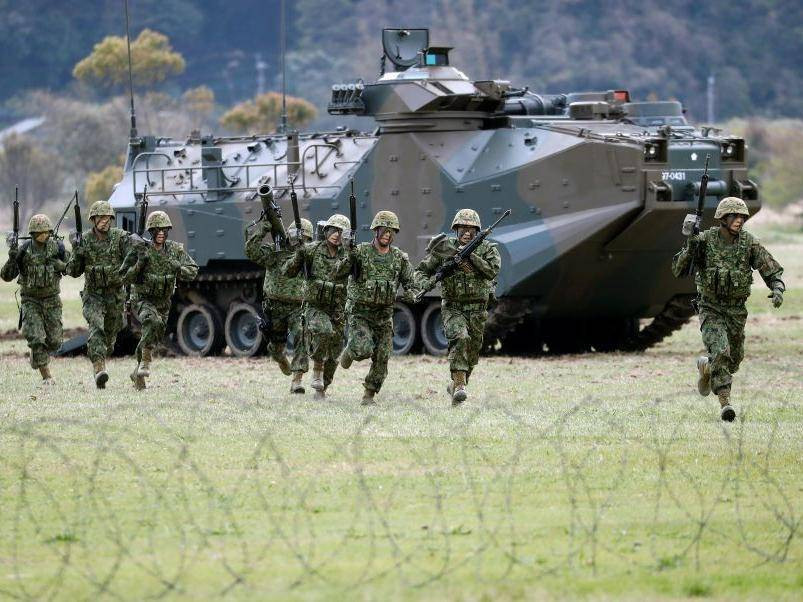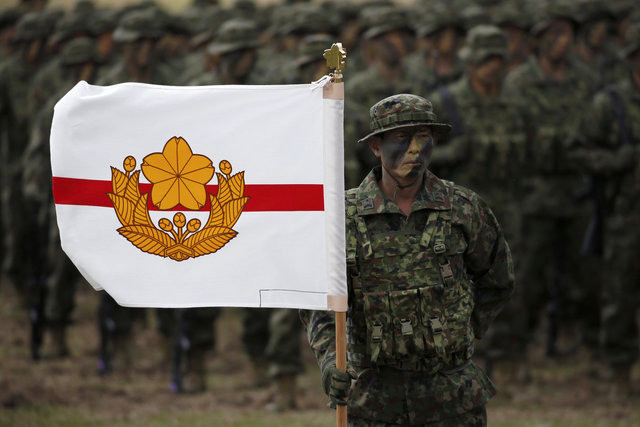What does Japan calculate when activating the marines?
(Baonghean) - Japan asserts that protecting remote islands is an urgent task in the context of the security situation surrounding the country becoming more complicated. This explanation is reasonable but not complete!
For the first time since World War II, the Japan Self-Defense Forces (SDF) has put into operation its marine unit. The marine force is tasked with protecting Japan's islands - stretching southwest from Kyushu to Taiwan (China). Japan asserts that protecting the remote islands is an urgent task in the context of the complicated security situation surrounding the country. This explanation is reasonable but not complete!
 |
| Japan's newly formed marine force conducts a 20-minute drill simulating the invasion of a remote island. Source: Reuters |
The route is mapped out
2,100 is the number of soldiers that will be in the newly launched Japanese Marine Corps. This force, called the Amphibious Rapid Deployment Brigade (ARDB), is expected to increase to 3,000 soldiers and will be developed in parallel with many weapons such as helicopter carriers, landing ships, amphibious assault vehicles... Japan does not hesitate to declare that the purpose of creating this force is to prevent the possibility of the islands controlled by this country in the East China Sea being attacked, as well as to retake offshore islands if invaded.
In fact, if we look back at recent times, this move by the Japanese government is not too surprising. Most recently, the Japanese Ground Self-Defense Force (GSDF) on March 27 underwent its largest organizational restructuring ever, with the launch of a Ground Command Center, allowing the military to effectively and quickly carry out defense operations across the country. The Japanese Ministry of Defense also recently planned to install fixed warning and control radar equipment on Iwo Island in the Pacific, to strengthen the country's air defense capabilities across the entire area covering the Izu and Ogasawara Islands.
Or earlier in December last year, the Japanese government approved a plan to increase the defense budget to a record high of about 5,190 billion yen, equivalent to nearly 46 billion USD. This is the 6th consecutive year that Japan has increased defense spending. According to the explanation from Japan, the defense budget for fiscal year 2018, which started on April 1, is to purchase missile defense equipment such as SM-3 Block IIA interceptors, the US ground-based missile shield system or medium-range cruise missiles...
Beware of China and North Korea
According to Japan's explanation, this series of steps is to strengthen the country's defense capabilities to deal with North Korea's nuclear and missile programs as well as China's recent steps to expand its influence at sea. This explanation is completely reasonable, as the threat from North Korea's nuclear and missile programs is always latent. Although at this time, the dialogue efforts of the parties are being strengthened towards the upcoming inter-Korean summits as well as the US-North Korea summit, aiming to denuclearize the Korean peninsula. However, for Japan, this cooling does not mean that the risks from North Korea are over.
 |
| A Japanese Marine (Source: Kyodo News) |
Meanwhile, tensions in the South China Sea and East China Sea have yet to be resolved. Of course, we cannot forget the defense investment strategy of our rival China. Right before the 13th National People's Congress in March, China announced an 8.1% increase in defense spending in 2018 to $175 billion - the highest level in the past 3 years. Earlier last year, the People's Liberation Army (PLA) also continuously made moves to accelerate modernization. These include launching the first domestically built aircraft carrier, opening the first overseas base in Africa in Djibouti... And at the beginning of this year, China announced that the J-20 stealth fighter was ready for combat and had been added to the armed forces...
It must also be said that this is a very favorable time for Japan to further accelerate its military reform, in order to get ahead in the race with China. Because the two "economic giants", the US and China, have been busy with sanctions and trade retaliation in recent days, causing public concern about a global trade war. Of course, if this war happens, Japan will be more or less affected, but clearly, the damage to China and the US will be much greater. Therefore, there is no reason why Tokyo should not take advantage of every opportunity to "take the lead" over its leading regional rival, Beijing.
Meanwhile, through a series of planned expenditures in the defense budget, such as purchasing missile defense equipment such as SM-3 Block IIA interceptors or the US ground-based missile shield system..., Japan will have more excuses to tighten its alliance with the US. And that, although there are still some views that do not agree with President Donald Trump, the US - Japan is still a strategic, strong alliance that makes China wary!
Ambition of "political power"
Not stopping at goals such as responding to China, North Korea or tightening relations with the US ally, observers say that Prime Minister Shinzo Abe's strategy goes further than that. Remember that last May, Mr. Abe announced a plan to establish a national army consisting of many components. Although the Japanese Constitution stipulates that the country is not allowed to build a military force to prohibit the use of military force to wage war with any country. However, the position of Japan's military forces has changed greatly since World War II. Not only that, Prime Minister Shinzo Abe has long cherished the ambition of being a "political power" and not just a "peaceful economic power". And clearly, in the context of increasingly complex regional and global developments, "a political power" must have a truly strong and regular military force.
Therefore, 70 years after World War II, in 2015, Japan made a historic decision to reinterpret the provisions of Article 9 of the Constitution, allowing Japan to exercise the "right of collective self-defense". Or before that, the Tokyo government also passed the decision to "relax the embargo on arms exports" to modernize the military, especially the air force and navy; increase engagement, and deal with all challenges in the region... Returning to recent moves, the latest of which is the launch of the Marine Corps, public opinion can easily see that this is a tight roadmap that Japan has planned for a long time!
However, Japan's acceleration of strengthening and modernizing its military forces has caused a wave of conflict among countries. While its ally, the United States, has always supported it, countries like China and Russia are "restless" and will certainly have strategies to respond. Of course, an arms race in the region will therefore become increasingly heated. It is not known who wins or who loses, but it is known that once "the gun is loaded", the situation in the region will have the potential to become unstable. Because, "no one will give in" if a conflict officially breaks out. That will only be an extremely bad scenario for all parties.


